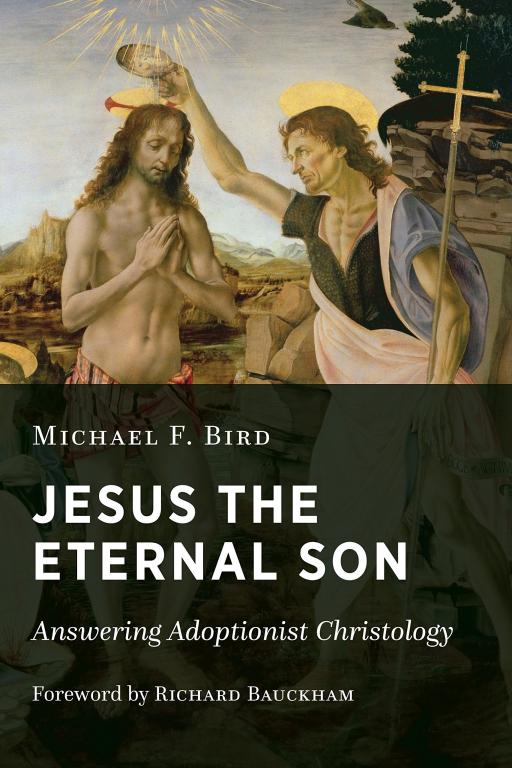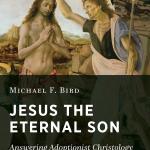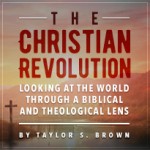
Another entry into this blog series, another twoish-week delay. I could say that I was working on a number of other writing projects, a lecture tour, and designer ink pens with my face on them (awe yes, that is the dream isn’t it?). I could say all that, but the truth is that laziness has simply gotten the better of me when it comes to writing. I have a day job and by the time I come home, the last thing that I want to do is apply my mind to the mentally taxing task of writing. This wasn’t helped at all by the release of the new God of War game this past Friday.
In short, I have let lethargy and entertainment properties lull me away from the life of the mind these last couple of weeks. Anyway, on to chapter four of Jesus the Eternal Son.
With the fourth chapter of Jesus the Eternal Son, Michael Bird dives headlong into the treatment of Jesus as the Son of God in Mark’s Gospel. In the preceding chapter Bird focused in on the context of Hellenistic deification and apotheosis parallels that are often brought forward in order to support an adoptionist Christological framework in Mark. There, he argued that while these parallels are interesting and even somewhat helpful in regards to their analogical content, when it comes to the actual genealogical relationship between such divine divinization/adoption texts and the Christology of Mark’s Gospel, the connections are very, very thin.
Having gone through the necessary background data regarding such Greco-Roman texts, Bird is able to fully investigate the meaning of Jesus as the Son of God in Mark’s Gospel. Bird engages in a close reading of the Mark’s Gospel in order to, “(1) contend against an adoptionist reading of the Markan story and (2) establish that Mark’s Christology as a whole exhibits a form of christological monotheism where Jesus is part of the divine identity” (p. 64).
The first part of this endeavor—contending against against an adoptionist Christology in Mark—is centered around, but not totally limited to, the scene of Jesus’ baptism in Mark 1:9-11. The reason for such an emphasis on the baptismal scene is explained by Bird right from the get-go:
The baptism [of Jesus] is crucial because it features Jesus’s debut in the Markan story. More specifically, it presents Jesus as a faithful Israelite who is baptized by John. The accompanying portents of a heavenly voice and the vision of a dove descending from heaven indicate, at the least, a revelation of divine approval with Jesus presenting himself for baptism. But approval unto what? (p. 65)
The “approval unto what” is exactly what Bird seeks to answer in the chapter. Bird begins this task by first addressing the recent and influential 2012 work by Michael Peppard, The Son of God in the Roman World. In the words of Bird, Peppard’s book, “critiques theological readings—i.e., explicitly Nicene accounts—of first century texts, while also seeking to interpret divine sonship in the socio-political context of the Roman Empire. Peppard reads the Gospel of Mark, especially the baptism episode, in light of Roman adoption practices and the imperial cults” (p. 66). Peppard thus serves as an important representative foil to interact with on the question of Mark’s Christology.
Bird’s interaction with Peppard’s work is thorough and extensive. Indeed, it is too extensive to extrapolate in detail in this post. Also, by this point in this blog series, you should have already picked up a copy of the book for yourself, so that you can read Bird’s analysis and arguments in their full depth. That being said, Bird’s argument against Peppard’s thesis that the Markan baptism scene is adapting Roman adoption practices can be examined by way of its three, key critiques.
Bird’s first critique of Peppard is: “(1) Peppard’s critique of the Nicene readings as focused heavily on ontological matters is unfair” (p. 67). Peppard’s critique is reminiscent of many modern theologians and scholars critiques of classical Christian theology. The critique generally goes something like: “Ugh, those terrible patristics ruined the pure, unadorned gospel of Jesus with their corrupting imposition of Greek philosophical and theological categories. They took Neoplatonism and ruined the gospel that didn’t care at all about questions of the nature of the Trinity, the hypostatic union, divine simplicity, and all these other abstract ideas! The Church Fathers ruined Christianity with their Greek philosophical influences!”
While this is a charming screed that has been thrown around in one form or another since the days of Adolf von Harnack, it is not only uncharitable to the complexity and nuance of early, ante-Nicene and Nicene thinkers, it also ignores the complex confluence of Hellenistic and Jewish thought that existed in the first century. Contra Peppard, Bird rightly notes that the abstract reflections on the nature of the divine did not, “begin with Cyril of Alexandria or the Cappadocian Fathers. These ideas had a long history in the Greco-Roman world” (pp. 67-68). Bird goes on to provides a variety of thinkers as exemplars of such kinds of thinking, from Socrates’s discourses on the nature of the gods, all the way to the Apostle Paul’s use of Hellenistic theological and philosophical language in service of his gospel proclamation. Such notions and discussions would have been, to a greater or lesser extent, “in the air” in the Greco-Roman world, and far from an anachronistic imposition on the New Testament texts hundreds of years later (pp.68-70). As Bird summarizes the matter:
…the claims made about Jesus by the church fathers were not merely the imposition of a platonic ontology or the attempt to run roughshod over socio-political images for sonship. More likely, Nicene Christology was the attempt to demonstrate the parity of a particular grammar of divine ontology with the christological narratives of Scripture… Nicene Christology was the attempt to exposit the New Testament’s claims about Jesus by utilizing the philosophical tools that were on hand. It was a deliberate theological reading informed by philosophy, but it was not therefore pure anachronism or mere allegory. (pp. 70-71)
The second critique Bird has of Peppard is that he severely downplays the presence of inter-textual, biblical allusions in baptism narrative of Mark. According to Bird Peppard so heavily emphasizes the perceived parallels between Roman adoption practices and the baptism of Jesus that he ignores a wealth of scriptural echoes that root the narrative far more deeply in Israel’s Scriptures. In particular, the voice from heaven in the narrative, who declares Jesus to be His beloved Son, blends together three major thematic streams from the Old Testament:
The voice from heaven then blends together a trio of scriptural images about the Davidic king, Isaiah’s servant, and the Akedah [the binding of Isaac] to reveal Jesus as a redemptive figure who will effect Israel’s restoration through the power bestowed on him through the Holy Spirit. The king is elected as son, the Isaianic servant is anointed for his service, and Abraham’s beloved son is readied for sacrifice. It is certainly possible that the baptism of Jesus may not have meant for Mark what it meant for later proto-orthodox and orthodox interpreters. Yet it seems evident to me that the intertextual allusions point to the call and commission of Jesus as the Son and Servant to complete his messianic task; it marks him out as the messias designatus [Messiah designate], not as one who becomes the divine Son at this juncture (p. 72)
Bird’s third critique of Peppard’s thesis has to do with the way that Mark’s intended audience would have understood the thematic elements of the baptism scene. Peppard (and a few other scholars) argue that the the framework of Roman adoption practices may have resonated with many of the Hellenistic hearers of Mark’s gospel (pp. 73-74). While this may have some credence, as Bird rightly observes the ways that readers respond to any given message or text can be near-limitless. Adjudicating the author’s intended meaning in a text cannot simply be left to resonances with readers; other criteria of meaning are necessary:
However, readers can be naive and contexts infinite. We have to find a way to adjudicate between different reader responses, especially if one is interested in pursuing a reading that seeks to be both coherent and normative for the symbolic world of the first Christians. I would suggest that what legitimates textual meaning is not how a text might resonate with any one person based on his or her own personal experiences and contexts. Such readings can be multiplied endlessly . . . Rather than treat all textual resonances as self-authenticating, I think what makes an interpretation preferable is that it creates a web of connections between the author, the text, and readers that is able to hold together all the multiplicity of factors in the reading process. So the question is not, could some Roman Dickianus or Greek Honarios look at the Gospel of Mark and say, “Hey, that reminds me of Vespasian’s consecration as a god and Nerva’s adoption of Trajan.” The question is, what reading best explains the author’s intention, the dynamics inside the text, the intended response for the implied reader, and the experiences of real readers that we encounter in reception history. A preferential reading is one that can hold together all those factors with a firm coherence over and against alternative proposals (pp.75-76)
To summarize what Bird is saying, it does not really matter whether or not a given reader might have resonated with the motif of Roman adoption practices while reading Mark’s gospel. The shared analogues of human experience means that readers and hearers will almost always find some sort of resonance with a text, biblical or otherwise. As a twenty-first century Christian, living in the United States of America, I find a great many resonances with the story of how Winston Churchill failed miserably with the Dardanelles campaign in WWI, only to learn from it and later play one of the key roles in leading the Allies to victory over Nazi Germany in WWII. The story smacks of grit, strength, and the triumph of the underdog. If I didn’t know any better I’d say it sounded quintessentially American. And yet, despite these resonances, Churchill’s own memoir’s of the event draw not on such American values and contexts, but on Victorian and Edwardian values of duty, honor, and loyalty to Queen and country. My resonances find analogues, but Churchill’s intended meaning has different roots than my perceptions of it. In the same way, possible, even probable resonances with Roman adoption practices does not at all mean that Mark wrote out of such a context. The scriptural and intertextual context provides a far more explanatorily powerful framework in that regard.
And indeed, Bird provides several such examples that counter Peppard’s thesis. For example, if Jesus was intended to be viewed as adopted in the baptism scene, then why are none of his exploits—the acts of virtue and courage that warrant divine adoption and/or divinization—explained? The adoption would need to be at the end of a long series of tasks accomplished, not at the beginning of the narrative (p. 76). Likewise, given how strongly emphasized Jesus’s pre-existence was in other early Christian texts (e.g., the Pauline corpus, the Gospel and Letters of John, the Book of Hebrews, etc.), any countervailing adoptionist themes would need to be quite pronounced in Mark. And yet we have much of the opposite, with demons—who did not witness the baptism— quaking in fear at Jesus, His forgiving of sins, and his calming of chaotic storm waters (pp. 77-81).
It is from this point of critiquing Peppard on the baptism scene that Bird moves to analyzing Mark’s Christology as a whole. Bird does this by looking at several major motifs throughout the whole of Mark’s narrative that emphasize the high Christological import of Christ’s person and actions. While Bird goes into a good amount of detail in this section (indeed, it covers nearly twenty pages), we will only be able to fly through some of the key aspects of the section.
Bird examines everything from the “Lord” (κύριος) language of Mark (pp. 84-92), to Jesus’s divine prerogative to forgive the sins of people (pp.92-94), to appearances of God’s power in and through Jesus (e.g., calming the storm in Mark 4, pp. 94-98), and Jesus’s divine authority in Mark as a whole (pp. 98-102). Again, I have to emphasize that Bird covers all of these topics in extensive detail. Unfortunately, I simply cannot delve into each one, as it would make an already long post exponentially longer. I can, at the very least, quote Bird’s own summation of the matter:
The Markan Jesus participates in the kyriecentricity of Israel’s God. He is identified as a pre-existent heavenly figure who has come to earth, who carries divine authority, who embodies a royal role; and in his person, words, and deeds he manifests the holy presence, the redemptive purposes, and the cosmic power of the Lord of Israel. In no case can Mark’s Gospel—when read in light of its own context, claims, and its intertextuality—be said to describe Jesus as a human figure who becomes the divine son at some point in his career. (p. 102)
So there you have it, chapter four has finally been waded through, despite my own lethargy! We’re almost done with the book, so be on the lookout for the last couple of posts in the future!











